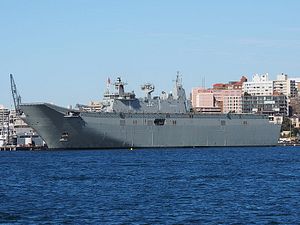As the Royal Australian Navy (RAN) is preparing to commission its second Canberra-class landing helicopter dock (LHD) HMAS Adelaide — at 27,800 tons, the RAN’s largest-ever ship class — by the end of 2015, a new study by the Australian Strategic Policy Institute (ASPI) finds critical gaps in Australia’s amphibious warfare capabilities.
“Australia’s position in the world makes the effort a strategic imperative, but the ADF still has a long way to go and many critical decisions ahead if it’s to develop an amphibious warfare capability that’s ready for future challenges,” the paper notes.
The first ship of the new class, the HMAS Canberra, was commissioned nine months ago. The ship can carry up to 1,046 troops and their equipment, around 110 vehicles and between eight to 18 helicopters that can airlift 220 soldiers at a time.
The Australian Defense Force (ADF) always had an amphibious warfare capability, the reports’ authors explain. However, since 1945, the ADF has never had to put its skills to test under hostile or opposed conditions. The paper, while acknowledging that Australia always possessed the hardware, notes that “the quality and capacity of the capability was never adequate for the perceived strategic and operational needs.”
“The ADF currently lacks the tradition, culture, and organizational expertise needed to maintain and employ a world-class amphibious warfare capability,” the ASPI report succinctly summarizes. Australia’s army in particular currently lacks resources and know-how: “Of the three services, the Army faces the greatest challenges in meeting the likely demands of the Australian Government for amphibious warfare capability … The Army is suffering from a deficit in key combat support and combat service support elements.”
Consequently, one the recommendations of the report is the creating of an Amphibious Center of Excellence in order to “evolve doctrine, provide for the learning of individuals, provide expertise to other ADF and single service courses and education facilities, generate training teams to assist in unit-level training, and provide highly-qualified staff to certify amphibious elements.”
Other recommendations include:
- The Australian government should clarify expectations for a future amphibious force, preferably in the 2015 Defense White Paper.
- The Department of Defense and Chief of the Defense Force should establish and empower a joint capability management system within the military with responsibility for amphibious warfare.
- The heads of ADF should empower a command and control mechanism for amphibious warfare by establishing a permanent component headquarters under the command of a jointly staffed Amphibious Task Group (ATG).
- The Chief of the Army should establish a system of tiered amphibious readiness within the Army and he should also commission a study in order to prioritize the Army’s key combat support and combat service support elements.
































